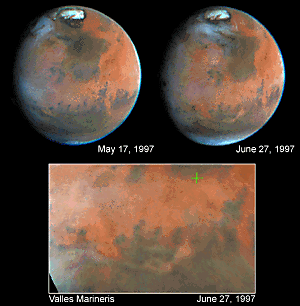"Unless the dust storm were to evolve into a massive, global event, its effects on the Pathfinder mission should be minimal," says Steve Lee of the University of Colorado in Boulder. "This is something we did not expect to see."
The Hubble astronomers also report the presence of patchy cirrus clouds over the landing site and very thick clouds to the north. Since there are so many clouds (related to low temperatures in the atmosphere causing water vapor to freeze), the dust will probably stay confined to the canyons, they conclude.
If dust rises to the elevations where the water-ice clouds form, ice condenses on dust grains and the heavier ice/dust particles quickly fall back out of the atmosphere. Though the dust could extend at low altitudes over the landing site, researchers say current prevailing winds should not take the dust northward.
"If dust diffuses to the landing site, the sky could turn out to be pink like that seen by Viking," says Philip James of the University of Toledo. "Otherwise, Pathfinder will likely show blue sky with bright clouds."
The imaging team includes Steve Lee of the University of Colorado at Boulder's Laboratory for Atmospheric and Space Physics; Todd Clancy of Boulder's Space Science Institute; Phillip James of the University of Toledo; Mike Wolff of the Space Science Institute; and Jim Bell of Cornell University.

Hubble Space Telescope images of Mars, taken on June 27, 1997, reveal a significant dust storm which fills much of the Valles Marineris canyon system and extends into Xanthe Terra, about 600 miles (1000 kilometers) south of the landing site.
It is difficult to predict the evolution of this storm and whether it will affect the Pathfinder observations.
The pictures were taken in order to monitor the site in Ares Vallis where the Pathfinder spacecraft will land on July 4.
The two images of Mars at the top of the figure are Hubble observations from June 27 (right) and May 17 (left). Visual comparison of these two images clearly shows the dust storm between 5 and 7 o'clock and about 2/3 of the way from the center of the to the southern edge of the June image.
The digital data were projected to form the map of the equatorial portion of the planet which is shown in the bottom portion of the figure. The green cross marks the location of the Pathfinder landing site, and the yellowish ribbon of dust which runs horizontally across the bottom of the map traces the location of Valles Marineris, a system of canyons which would stretch from Los Angeles to New York if placed on Earth.
Most of the dust is confined within the canyons, which are up to 5-8 kilometers deep. The thickness of the dust cloud near the eastern end of the storm is similar to that observed by Viking lander 1 during the first of the two 1977 global dust storms which it studied.
Other interesting features appear in this image. The northwestern portions of the planet are enveloped in unusually thick water ice clouds, similar to cirrus clouds on Earth; some clouds extend as far as Lunae Planum, the slightly darker region about halfway from the center to the left side of the map. The dark spot near the terminator (boundary between day and night) at about 9:00 in the June 27 planet image is Ascraeus Mons, a 27 kilometer high volcano, protruding through the clouds.
The remnant north polar cap, composed of water ice, is at the top of the May and June images, and a bluish south polar hood, composed of water ice clouds, is seen along the southern edge. Because the planet's axis is tipped towards us during this season, we cannot see the south polar cap, which is in winter darkness.
Credit: Steve Lee (University of Colorado), Mike Wolff and Phil James (University of Toledo) and NASA
 Information on the landing site
Information on the landing site Hubble images show cloudy cold weather awaiting Mars Pathfinder
- Press Release 20 May 1997
Hubble images show cloudy cold weather awaiting Mars Pathfinder
- Press Release 20 May 1997 Mars Pathfinder page
Mars Pathfinder page Mars home page
Mars home page Author/Curator:
Author/Curator: